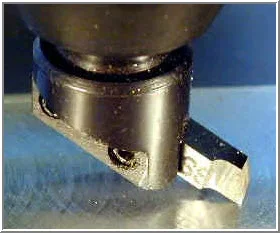I have been working with my big fly-cutter for surfacing (does a great job!) but then I wanted to make a "small" radius (1" or so) in a project. After much mucking about I made a nice little flycutter that was incorrectly milled... the cutter would not be on the center of roation. Probably would work... but the redo is here... On the bench you can see the "failed" cutter.
A trial run tells me it should do the job. Will show pics of the project when it is complete...
Rough specs: the shaft is 0.75" to be held in an R8 collet... no flat for a "weldon shank" affair, but might be a good idea.
The head is approximately 1.1" diameter. Original size was good based on stock at hand and keeping the overall diameter big enough to handle the work at hand.
Used with 1/4" HSS tool - worked well. Figure with brazed carbide like the large cutter this little guy would make a great medium surfacing tool.
4mm set screws hold the tool... 3 is probably overkill.

A trial run tells me it should do the job. Will show pics of the project when it is complete...
Rough specs: the shaft is 0.75" to be held in an R8 collet... no flat for a "weldon shank" affair, but might be a good idea.
The head is approximately 1.1" diameter. Original size was good based on stock at hand and keeping the overall diameter big enough to handle the work at hand.
Used with 1/4" HSS tool - worked well. Figure with brazed carbide like the large cutter this little guy would make a great medium surfacing tool.
4mm set screws hold the tool... 3 is probably overkill.

